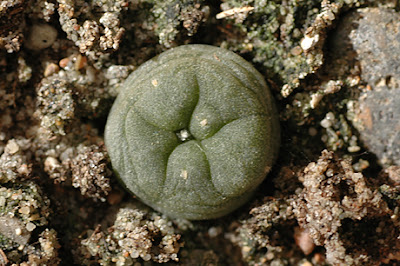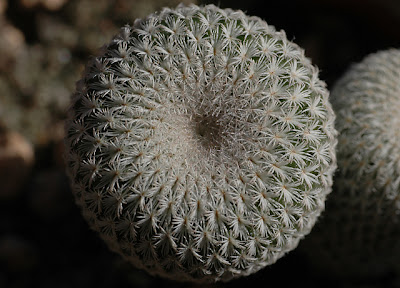Since 2004 I’ve experimented with growing Lophophora, Epithelantha, and Acharagma in an unheated greenhouse in Denmark. The winter this year has been damp but not very cold - the coldest temperature registered in the coldhouse was -5C (23F) – so even the L. diffusa plants are doing great. 
Lophophora williamsii (SB 854; Starr Co, Texas)
The L. williamsii plants (sown May 2004) are thriving in the coldhouse. The epidermis is glaucous bluish-green, much truer to the type than plants grown in my windowsill. All my cold grown Lophs are wrapped in horticultural fleece during winter – not so much because of the temperature, but to avoid attacks from various critters. This kind of damage is not a problem with the spine covered species.
Lophophora diffusa (Higuerillas, Queretaro, Mexico)
In 2005 I sowed L. diffusa and L. decipiens to grow in the coldhouse. Especially the L. diffusa plants had a hard time last winter and only 2 survived. Both are now doing fine and are developing the typical yellowish-green epidermis. 
Lophophora decipiens
L. decipiens is not a “good” species; it’s probably just a cultivar form of Lophophora fricii (I couldn’t obtain any collection data for these seeds either when I bought them). Anyway, the plants are doing well and are getting ready to go 8-ribbed at an age of two.
I’m growing both “regular” Epithelantha micromeres and Epithelantha micromeris v. gregii. The gregii variety seems to be a faster grower than the regular micromeres; it also has a very beautiful coverage of spines, as illustrated below.
Epithelantha micromeris v. greggii (Cuesta la Muralla, Coahuila, Mexico)
Epithelantha micromeris v. greggii – closeup
All of the Epithelantha plants made it through this winter without damage.
Malpighia 1927 v.30 (added: 11/24/2025)
-
*By:*
Borzi, Antonino,1852-1921.
Penzig, O.1856-1929.
Pirotta, Romualdo,1853-1936.
*Publication Info:*
Messina : g. Capra & co., 1887-89 ; Genova : Tip. di A...
2 weeks ago



















Beautiful photos.
ReplyDeleteIs the natural light in Denmark sufficient to grow these cacti at the same rate they grow in their native habitat?
Do you ever use artificial light?
I have a collection of L. diffusa plants that I have always protected from freezing temperatures. I believe that after reading about your cold tests, I will experiment next winter too. I have San Pedro too that I am about to start using as grafting stock..this will be a first for me too. I live in South Texas and can't grow williamsii. I enjoy yor blog. I hope to start one soon.
ReplyDeleteChuck, thanks for the comment – it’s good to know my ramblings are being appreciated ;-) The plants I use for the cold hardiness experiments are all seedlings raised specifically for this purpose, i.e. I haven’t risked loosing large, well established plants (yet – this summer I will move a handful of L. williamsii plants that I can’t find room for in my windowsill to the coldhouse). That being said I would be glad to learn about the results of your tests – what is the minimum temperature in your area? Also, if you start a blog, could you post a link to it here as I’m very interested in other people’s experiences in this area.
ReplyDeleteRegarding the light, I don’t apply any sources of artificial light; the plants have to do with what they can get from the sun. They probably aren’t growing at the same rate as they would be in their natural habitat given exactly the same conditions, but other factors than light levels also vary. Cultivated plants usually have access to ample supplies of water and nutrients, habitat plants don’t. The plants are kept dormant during periods of low light to avoid having them grow etiolated. This is accomplished by withholding water completely in the period between the autumnal and vernal equinox (seedlings grown indoors need a bit of water during this period in order not to wither completely).
The mature lophophora that I have were grown from seed in a greenhouse that I used to have. I have about 10 that vary in size. They are all the same age however some are one half inch in diameter and some are 4”. I started them in 1999 and they are all healthy. My greenhouse caused erratic growth due to its heat through out summer. It was really hard to keep cool in the summer, a lot of days were over 100 degrees f. and that was with an evaporative wet wall, exhaust, and circulating fans. Hurricane Rita destroyed my greenhouse and I now have all my plants (cacti, bonsai, succulents) outside. I just started several new seedlings of lophophora diffusa, fricii, and decipiens in a seed tray under florescent lights. They are 4 weeks old and I will use some of these for a cold exp. next winter. The diffusa strain is from central Mexico where it doesn’t freeze and the literature that I have read warns of allowing it to freeze, whereas williamsii being from further north has acclimated to withstand light freezes. Most of my cactus is from Arizona, New Mexico, and Texas; all very spinney and unaffected by freeze. The lophophora is my favorite still, I guess because it is so unique. My graft of a 1” diameter diffusa onto a San Pedro seems to be totally well bonded and ready to take off. The diffusa that I have, haven’t ever made pups, therefore I hope that the grafted one will respond to the “extra juicing” from the San Pedro with pups. I will post some pictures soon and provide a link. Your site here is the best source of information on lophophora and much appreciated.
ReplyDeleteI'm sorry to hear you lost your greenhouse to Rita, but it's good your plants survived. It is also my experience that L. diffusa is more susceptible to frost damage than L. williamsii - during the much colder winter 2005/2006 a lot of my diffusa seedlings succumbed while most of the williamsii plants weren't marked at all.
ReplyDeleteI'm looking forward to seeing your pictures.
This is Chuck one more time. I just started a blog and it obviously needs refining. I started it with a picture of my diffusa. http://chuck54.blogspot.com
ReplyDeleteChuck, sorry for the late reply – my job has taken a great toll on my time lately.
ReplyDeleteI’ve posted a more detailed comment at Chuck’s blog (the blog features information on cling wrap grafting).
Hi friend
ReplyDeleteThere are just a little of information about lophophora and direct sunlight. I have a three years old lophophora and want to know if seven hours of direct sunlight per day is too much or no.
I live at a tropical country with lots of sun and rain every day.
Your blog is the best i find about these issues.
Thanks
Lobo do Deserto
Lobo, given the natural habitat of Lophophora I would say your plants should be able to endure seven hours of tropical sun per day if properly acclimatized. Slowly introduce the plants to increasingly more sun every day; if they assume a reddish hue they are receiving too much sun, i.e. they are getting sunburned, and should be protected in the shade. I would probably worry more about the rain ;-) May I ask in what country you live and what species of Lophophora you are growing?
ReplyDelete